Canning most foods is nothing new to most preppers. Yet, only a few of you know that you can also make canned bread at home
You heard that right. Bread can too be canned and preserved for two to five years. Some even claim that period can be extended up to ten years.
Imagine having such a staple food always ready whenever you need it. You can have it with any meal a day, accompanied by whatever you like.
I used to be hesitant before trying it, fearing it would be a little too complicated to make or even time-consuming, but, to my surprise, it was quite the opposite. I found the process to be really simple, fast, and easy.
It turned out that making canned bread is as simple as making regular bread. The only difference lies in using canning jars instead of regular baking trays.
The thing I love most about bread recipes is how extremely versatile they can be. Therefore, feel free to use any recipe that you like, or simply substitute ingredients or add and let go of other ones, adjusting to your preferences and available products.
Some traditional recipes, like Boston brown bread, use a mix of whole grains, often with molasses, to give a unique flavor. If you’re looking to experiment, you might try incorporating similar ingredients into your canned bread for a richer, old-fashioned taste.
Before getting to the recipes, here are some important instructions for making canned bread.
You should use wide-mouthed jars. It will help you get your bread out easily once it has been cooked, without messing up its shape or damaging it.
Sanitize your jars properly before using them. We don’t want any dust or germs in our bread. Make sure you have your jar lids ready to seal immediately after it’s cooked to avoid air from getting in.
Canned Bread Ingredients
I chose to make carrot bread. The recipe I used makes about 6-8 jars, depending on the size.
I did cut the recipe in half this time. Feel free to double it or adjust it to you needs. To make this bread you will need:
- 2 cups of sugar
- 1 cup of vegetable oil
- 3 large eggs
- 2/3 cup water
- 1 teaspoon baking powder
- 2 teaspoons baking soda
- 1/2 tsp salt
- 1 tbsp cinnamon
- 2 c. grated carrots
- 3 cups flour
- 2/3 cup nuts/ raisins/ chocolate (optional)
- 1 tsp vanilla extract (optional)
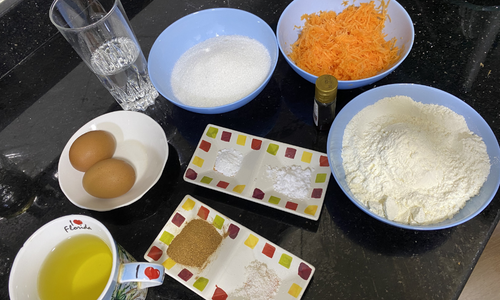
Alternative Ingredients
As I said before, feel free to substitute carrots with any available ingredients, whether it’s a fruit, a vegetable, or a sauce. You can also add any type of nuts, chocolate, or dried fruit. Whatever you and your family fancy.
Here are some of the alternative measurements if you choose to not opt for the carrots.
You can use 2 cups of: shredded zucchini, mashed bananas, shredded apples, canned or cooked pumpkins, pineapples, or peaches.
Related: 10 Vegetables That You Can Stockpile Without Refrigeration For A Full Year
You can also use 1 can of cranberry or pineapple sauce. Or you can get creative and mix different ingredients such as bananas and apple sauce together, with raisins and nuts. It’s up to you. Make it fun.
If you can find shortening, it will be a great substitute to use instead of oil as it doesn’t go rancid as fast. I couldn’t find any so I opted for oil.
You can also experiment with different flours to vary the texture and flavor of your canned bread. For example, substituting part of the all-purpose flour with rye flour can add a slightly nutty taste. If you’re a fan of denser, heartier bread, rye flour is an excellent choice.
Some recipes call for for coconut, avocado or olive oil. I think they are strongly flavored. If you don’t mind the taste of them being present, you can use them. I personally always go for vegetable oil instead. It’s a cheaper and flavorless alternative.
Boston brown bread is a great inspiration for canned bread lovers. It traditionally uses a mix of whole wheat, rye flour, and cornmeal along with a touch of molasses, which can give your canned bread a unique, sweet taste. Feel free to adapt your recipe to include some of these traditional ingredients for a twist.
Directions
1. Preheat your oven to 325 degrees.
2. Prepare your jars by sterilizing them and greasing them using any oil of choice, nonstick spray, or butter.
I used soap and hot water for the sterilization and coconut oil for the greasing. Then, place them on a baking tray, ready to be filled.
3. In a large bowl, cream the sugar and oil. Add in your eggs, mixing well.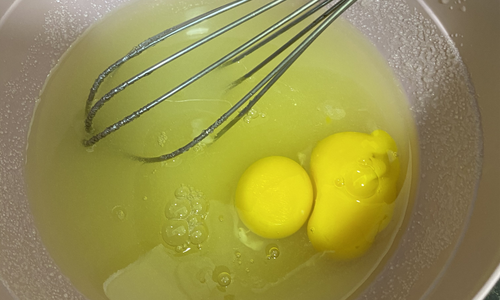
4. Add water and vanilla extract. Then add in the carrots or your ingredient of choice.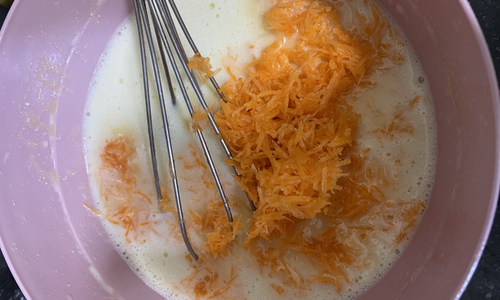
5. In a separate bowl, mix all the other dry ingredients. Add the wet mixture to them and blend.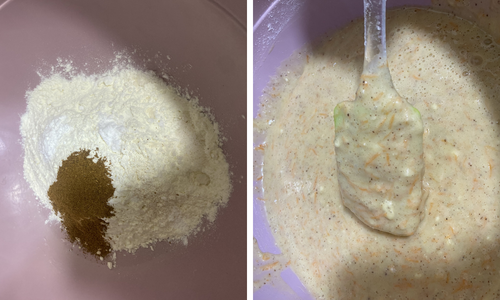
6. Lastly, stir in your nuts or raisins. I used a mix of walnuts almonds and raisins.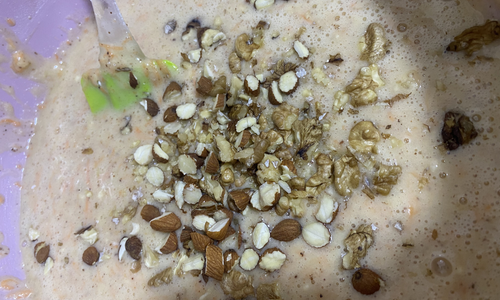
7. Pour the mixture into the prepared jars, filling them only halfway through. If you overfill them, the batter will overflow and your jar will not seal well.
Related: 7 Deadly Canning Mistakes Even Smart People Make
It’s okay if you make a mess too. Just wipe off the tops of the jars ensuring there is no batter on the tops.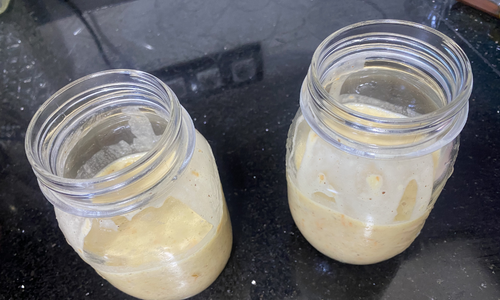
8. Bake them in the oven for 45 to 60 minutes, or until a toothpick comes out clean. It took mine about 50 minutes to be ready.
If you’re incorporating rye flour or experimenting with recipes similar to Boston brown bread, note that the baking time may vary slightly. These ingredients might make the bread denser, so keep an eye on it during the final baking phase.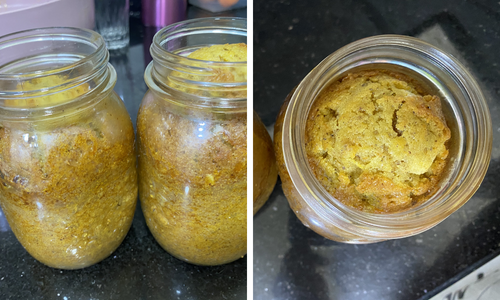
9. When done, remove the jars one at a time. Wipe the rim with a cloth to clean it and then place the lid on your jar, sealing and securing it. Repeat with the remaining jars.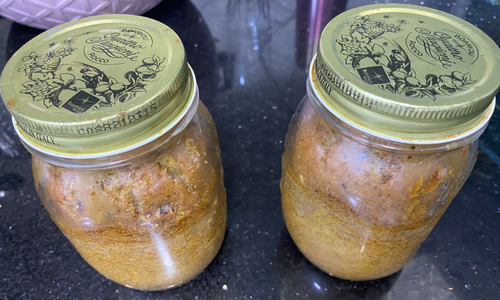
10. Put your jars back in the oven until they completely cool down. The heat helps them seal better.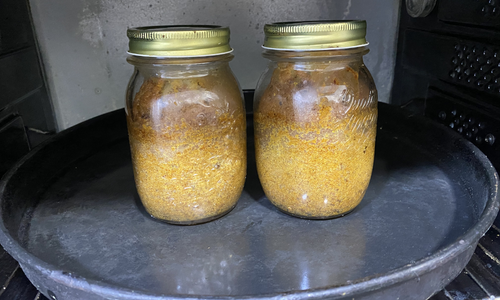
After they have cooled down and you take them out, place them in a dry dark place until ready to be consumed, and enjoy. If sealed right, canned bread will last you for 5 years on a shelf.
I made this bread two different ways. Both times, the final product was absolutely delicious and we devoured a couple of jars within weeks and just saved the rest.
Now I know there are people who find it hard to trust canning that much, so there’s another alternative way to make your bread ahead and save up time.
Make your own dry mix in jars. You can combine all the dry ingredients, mix them well, and leave adding the wet ingredients, such as eggs, water, and oil until you are ready to use.
When that’s the case, you transfer your dry mix into a bowl, just like you would a store-bought one, add in the wet ingredients, mix and then pour into an oven pan to bake.
If you opt for this way, make sure you mention each jar’s ingredients on a note attached to it as well as dates, ingredients to add and any other useful information.
This also works for cakes. A tip to extend your mix’s shelf life is to add a commercial oxygen absorber to it.
You may also like:
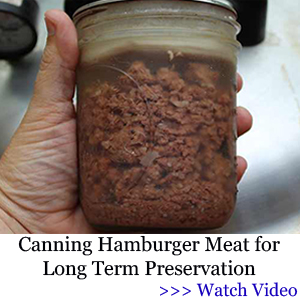 14 Survival Trees You Can Forage For Medicine
14 Survival Trees You Can Forage For Medicine
The ‘Superweed’ That Saved Large Communities During The Great Depression (Video)
Home Security Mistakes That You Are Probably Making Right Now






















Bread isn’t very hard to make.. I often sell it at my local farmers market.
Good way to get botulism
My grandparents prepared and stored food’s every summer. Their pantry was a small bedroom with shelves. They boxed the canned food’s. I lost my Grandma in 98 and my Grandfather in 99. They learned from their parents before them all the way back to the Rez. We have never had a case of botulism. We used the last jars in 2002. Off griders still put away food’s and keep a full pantry. Our food is safer than canned food’s at grocery store’s.
A quick google search brought up this from Clemson University.
Clemson Extension strongly discourages consumers from canning cakes and breads in jars. Botulism is a serious and often fatal disease and no consumer should take unnecessary risks with this microorganism. If someone gives you a home canned cake or bread product, assume that it is unsafe to eat and discard the contents.
The microorganism to be concerned about in these products is Clostridium botulinum. If spores of this bacteria are allowed to germinate and grow, deadly botulism toxin is produced. Tiny amounts of this toxin can cause an often fatal disease called botulism. Clostridium botulinum spores are abundant in nature but will only grow and produce toxin in unrefrigerated high moisture foods that are low in acid and exposed to little or no oxygen. These conditions occur in low acid canned foods; low acid canned foods must be processed under pressure at temperatures of 240°F or higher to make sure that the heat resistant spores are killed. Research at Penn State has shown that low acid canned bread or cake products may support the growth of Clostridium spores.
I thought I had heard this before and I was right, DON’T MESS WITH THIS PROCEEDURE, just bake your bread as needed.
guess I’m lucky to still be alive after 60 some years… I always throw away jars or storebought cans if they are in any way warped or seem damaged. Europeans have canned for ages and very view ever heard of pressure canning.
Here is a screen copy of a simple Bing Search:
How common is botulism in the US?
In the 5 years from 2011 through 2015, an average of 162 annual cases of botulism was reported. The respective proportions of each botulism type ranged from 71% to 88% for infant botulism, 1% to 20% for foodborne botulism, 5%-10% for wound botulism, and 1% to 4% for botulism of other or unknown origin.
Botulism – StatPearls – NCBI Bookshelf
Everybody has to decide for themselves and thanks to the internet it is really easy to educate yourself propperly.
In the period 1899-1949, 477 foodborne botulism outbreaks were recorded in the United States, and in the period from 1950 through 1996, an additional 444 outbreaks were reported to CDC for a total of 921. The average number of outbreaks per year has changed little, 9.7 per year for the earlier time period and 9.4
per year since 1950.
For the period 1899-1949, 1281 cases of botulism were reported, and in the time from 1950 through 1996, and additional 1087 cases were reported, bringing the total to 2368 cases. The average number of cases per outbreak has remained constant: 2.6 cases/outbreak in the first half of this century and 2.5 cases/outbreak so far in the second half. For the period 1899-1949, the case-fatality ratio was high at approximately 60%, but since about 1950, mortality has gradually decreased. For the period 1950-1996, the case fatality ratio was 15.5%. This decline in case-fatality ratio is due primarily to improvements in supportive and respiratory intensive care and perhaps to the prompt administration of antitoxin.
I went back and opened up the link to the related article ” 7 deadly canning mistakes”. It covers botulism it foods that are not high acid or properly pressure cooked. I am disappointed that this site would even put the article up about canned bread.
Thank you for sharing your insight. I couldn’t help but notice your name; are you an earthbag home builder?
Hi Happycamper, I built a geodesic dome about 20 years ago, just moved out lately. It is 2X6 construction from Oregon Dome.
When this is done and still hot, why can’t you put it in a pressure canner and boil it for 10 minutes and kill the spores if there are any. How does it live through 350 degrees in the first place?
The settlers lived of hard tac bread. My people kept pemmican with fat, dried meat and blue berries that never went bad. I trust homemade canned foods over the big canned food conglomerates any time! You won’t find bug’s and worse in our ingredients. We know what is in our food.
T.M.D.M.
My wife is Indian, and I trust home food over any box store. We groud up on home canned food, some of it was old but still good and we never got sick from anything that we grew or canned.
Also, no preservatives, only natural preservatives. We also did not fallow any FDA guide lines. Don’t think we even knew what FDA meant, at that time. Still don’t care what it does mean. They LIE…
Would love to have some homemade food, that you cooked…
Do you have a true Pemmican recipe, that will not go bad, as you said in your post.
I tried and it worked but then went bad?
Thank you
stay sharp
Old School tried and tested true still the way to go.
because it may be 350 on the outside, but not in the middle.
This is the same question I asked I can but didn’t know about canning bread. I have canned the flour and other ingredients for bread. The temperature is 300 degrees F and 10 minutes in a canner will kill every Bactrim that have harmed human beings for centuries. Extremeophiles haven’t as yet harmed humans but their environments have. Please explain how Botulism after 10 minutes over 300 degrees F live?
Hi there, I’m Selene. I’m a retired RN. So, to answer your question about how the botulinum toxin survives after 10 minutes of over 350F. The bacterium is a nasty little bugger for sure & the spores are heat resistant! Plus, it’s an anaerobic bacteria which means it does not need oxygen to survive, thrive & multiply! Someone else said it best when they said that in the end everybody has to decide for him/herself what they are comfortable consuming. For me it’s the fact that while you could survive an attack today with prompt treatment, if there was no antitoxin available, say like a post SHTF situation, you would die after suffering horribly. Botulinum is a neurotoxin. It attacks the nerves that supply sensation to your everywhere. Neuropathic pain is considered some of the worst pain there is. Sounds like a slow painful way to go to me. These days we get about 110 cases/year in the US, 25% of those are from food borne illness & it’s equally divided among men & women. Personally, I’ll admit to a vice or two (or 10; at my age God looks the other way-lol) but gambling isn’t one of them. Nope, not rolling the dice on home canned food unless either I canned it myself or I knew the person who canned the food & knew for a fact they were as picky as I am about it. To each his own though! Peace & Blessings to you in this New Year!
The issue is heat penetration. Dry product doesn’t transmit heat the same as wet product does. So even if the outside of the jar gets hot, the dry product on the inside may not get up to temperature long enough to produce a safe product. Here is a link you might enjoy. I have been canning for many years, and use this site like the Bible.
General Canning Information
The article says 325 degrees for 45 to 60 minutes minutes. And as ZeroTurnZed explains, put the lids on as described and return to pre-heated 325 degree oven to cool down. Daniel Bridger also makes an interesting suggestion re boiling in a pressure cooker for ten minutes as a final procedure. Has anyone ever tried to culture a product processed this way to see if botulism survives after numerous years? This would be a valuable exercise to carry out. Have our highly paid scientists ever doped a product such as this with botulism spores to see if they survive the cooking/heat treating, canning, and pressurizing process and several years in storage? That would be a worthy exercise for them to carry out, rather than wasting their time theorizing or covering up corporate sins; nothing beats real life or serving humanity.
While botulism bacteria can be killed by canning and the toxin can be deactivated by heating before consumption, home canners do not have access to the type of equipment needed to achieve the consistent pressure and heat penetration to destroy botulism SPORES in baked goods. Spores produced by the bacteria Clostridium botulinum are heat-resistant and exist widely in the environment including soil, river and sea water; and in the absence of oxygen they germinate, grow and then excrete toxins. Before pressure canning was available, people would oven can or water bath can low acid foods, but boil the food for 10 minutes upon opening to deactivate any botulism toxin, and that made the food safe. But that doesn’t work for bread. Opening up a can of bread, tossing it into some type of liquid, and heating it at a rolling boil for 10 minutes will not give you an appetizing result. That’s why we don’t can bread at home. B&M makes a great commercially canned bread if you want to stock it.
If you are terrified of home canned bread, get the B&M canned brown bread. I am 70rys old and have been canning for MANY, MANY years ,including bread and am still here!!! The way to do it is a clean environment and follow all sanitation procedures religiously!! The FDA is a lying corrupt agency of the corrupt gov. i don’t’ trust them at all. I go with with my grandparents(who taught me) who canned and persevered food and survived the great depression and lived to be 100 plus!!
Since I don’t can, I was going to print this one out for future reference and safe keeping just in case I want to give it a try. After reading the comments, I think I’ll pass. A big thank you to all who took the time to post.
With things coming items will be in short supply just take the 2nd option preserve the ingredients.though it will work if you follow the steps exactly.i grew up on home canned foods most low acid foods you add salt to anyway.
Low acid canned foods must be processed under pressure at temperatures of 240°F or higher to make sure that the heat resistant spores are killed.
Step 1. Preheat your oven to 325 degrees.
Step 9. When done, remove the jars one at a time. Wipe the rim with a cloth to clean it and then place the lid on your jar, sealing and securing it. Repeat with the remaining jars.
Step 10. Put your jars back in the oven until they completely cool down. The heat helps them seal better.
So, since home canners don’t follow these directions for safe canning of foods, you should get rid of your canning supplies and only buy food produced and packaged by government controlled manufacturers because the government would never let them make and sell something that is tainted or contains harmful ingredients. Guys your wife may be your executioner with her unsafe cooking practices. You should only eat at government approved cafeterias or restaurants. Home cooked meals are not safe.
The same goes for your ammo, get rid of your reloading equipment because you don’t know what you are doing and your gun will explode when using ammo that was not produced by a government controlled manufacturer.
I have never gotten anything from a government controlled manufacturer that was defective in any way, shape, or form. Because the government is here to protect me.
I did buy a loaf of cheese bread from an Amish grocer a few months ago and ate it all. I’m worried that I’m going to die some day due to eating that government unsanctioned bread. Who knows they might have prepared and baked that bread in their outhouse.
While dooms day prepping does have its great information it also creates a certain degree of stressful paranoia that will kill you sooner than anything else you are doing, except maybe bungee jumping without a good bungee.
Most of the food I grew up eating was home grown and canned by my mother. Food in glass jars is so much better tasting than in cans.
Sorry for the loss of your grandparents. I lost my mom in 2008. She was 93. It had been a while since she was able to can. I’m going to give bread canning a try. The recipe in the article sounds more like desert than bread. Did your grand parents ever try canning that sort of food?
Finally grasped the irony. Thanks. I also read books written without government guidance or supervision or screening. I can confirm that this has warped my thinking.
…
For the Better.
Won’t there be steam captured inside the jar which will make the bread soggy as it cools and turns to water?
350 for 45 minutes to an hour and it stays above 212 for a longer time while cooling in strile jars. Why would there be any mold? Serious question, not a comment.
Daniel, maybe it will help if you think about it like cooking a prime rib roast. A 8 lb roast in a 250 degree oven for 4 hr will only be med rare @ 140 degree. It takes a long time for the heat to reach all the way to the center. Later in the posts is a reference to the Ball Canning Book,I will bet it has been in print since 1930, we don’t have to reinvent the wheel here.
(good for you for wanting to learn)
There you go another one with common sense.iv eaten green beans that I canned 5 or 6 years later that lost a very small amount of flavor like store bought canned beans.just do it correctly when you open any canned foods 1st make sure it is still sealed then smell then taste.just like dog stuff. if it looks like it if it smells like it-it probably is.
Vegetable oil is much worse for you than you think. It is especially hazardous if it has been in a french fry cooker at McDonald’s. Vegetable oil is mostly Omega 6 oil. You need lots of Omega 3 oil to counter it.
Let alone that a lot of that generic “vegetable oil” is actually GMO soy or corn oil that is poisoned, or should I say the plant is SLATHERED with glyphosate to bring it to harvest all at once. Then, the glyphosate in the product also leaches the minerals out of your tissues and your bones, and you end up REALLY, REALLY SICK!!! Not worth it to use “vegetable oils”, we only use Avocado or Coconut Oils for frying as they are high temp oils and EXVirg Olive Oil to salad dressings, etc…not for frying, as it turns to transfat at a pretty low frying temp. Everytime you overheat Olive Oil, it is putting one more “brick” on the coffin or your heart! TRANSFAT is deadly!!
You are correct. I haven’t used any type of seed oil for the last 3years. When I have to buy stuff from the store and read the ingredients I cringe. I only use extra light olive oil, coconut oil, lard and real butter. I will be making this bread. I have so much zucchini and no more room in my freezer.
I wouldn’t put any nuts into any bread slated for long term storage. The oils in them go rancid . They’ll freeze well for at least a year when sealed up, but they’ll go bad rather quickly in room temperatures.
Really,Why does a jar or can of peanuts or even peanut butter last so long?
@Jeff S:
Peanuts are not actual nuts, they are a legume and grow underground like potatoes. Nuts grow in trees.
For novices just learning to can. Low-acid foods are pressure cooked and High-acid foods use the water bath method; correct?
And these methods cannot be interchanged for the Low and High acid foods as mentioned in some of the comments.
Is the Ball Canning Book considered the Bible for canning? Are there other sources to use?
Thank you,
I go by the Amish methods & they safely can low acid foods ALL THE TIME in water bath canners. Meats=3 hours at a true rolling boil.
Look up some videos on these methods. I haven’t died yet, or become Ill. That being said, I am not sold on canning bread, but would can the dry ingredients.
You can’t water bath can meat
I do have some very close friends that are Amish, but they use the water bath canner for FOUR hours over in our area! That is how they can their chickens and venison. I have witnessed this first hand.
It is true you should pressure cook low acid veggies and meats. In fact I wouldn’t do it any other way. But saying that, way back when they didn’t have pressure cookers and water bathed everything. I can every year and we are still eating stuff from 5 years ago and longer. More people get sick from fast food than grandma’s canned food. Fear porn
Serious question. How do you get the bread OUT of the jar without tearing it up and ruining it?
I find it hard to believe that the author is the only one who does this. So why don’t we see all kinds of stories about people getting botulism doing this? If just 1/100 of a percent of Americans get botulism from doing this that’s almost 35,000 people which we WOULD hear about. But we haven’t. ‘Splain that Lucy.
Also there are only about 110 cases of botulism every YEAR in the US. NOT 35,000. It’s rare as hens teeth and we would hear about it. I might take the extra precautions of pressure canning it after it’s cooked but it seems like overkill.
According to the CDC, only 25% of the 110 cases of botulism is foodborne-caused botulism. That makes it just 27.5 cases per year.
70% of the 110 average cases per year are from infant botulism which is often caused by ingestion of corn syrup and/or honey.
***That means there are only 8 cases per year of botulism from canned products.***
(Info from the CDC information)
I’m part of a Rebel Canners group where there are plenty of people who can bread. No one has mentioned getting botulism. And believe me, fearmongerers would surely shout any single case of botulism from home-canned goods. Big Food want us too scared to can our own food.
What you said 100%!!
I am also part of one of those groups…ppl are so fearful. I wonder how they will get by if they are afraid to preserve their own food. ?
I stand corrected about botulism numbers but my point stands—it’s VERY rare from food including home canning. Unless someone is going to try to say “not all cases are reported “. THAT is BS.
BTW the link you showed GottaGo323 is w where I got my info I was just too lazy to read past the 110 number. Lol. I have the canning equipment but haven’t used it in a while but I may do the bread canning just to see what happens. One batch without pressure canning and one with. Then wait a month and try 1 can if each. Then a year later do it again with the same batch. Etc etc to see how long it lasts doing it both ways. If I get sick and die I will let you know—somehow. Maybe through David Copperfield or some other phsycho –I mean psychic.
I’m about as worried about botulism in home canned foods, as I am about being strangled to death because I happen to wear a survival type necklace made out of 550 cord. Can it happen….yes, I guess if I happen to be climbing high up in a tree, and suddenly go into an epileptic seizure, and fall while dragging my neck against every branch on my way down.
There’s only one statistic that REALLY scared me, and that was when I read that 90% of ALL car accidents happen within a couple miles of home. When I read that, I MOVED.
I mean come on people, try applying just a tad of common sense here. If the gov. says it’s going to sunshiny and bright at high noon tomorrow, I’m bring an umbrella and a flashlight. The last thing they want is for anyone to be self-reliant, so what do they do, put out the old….”YOU’RE GOING TO DIE” statement.
Besides, canning your own bread is much cheaper than buying canned bread from B&M, and that canned bread last several years. We always had some in our pantry growing up. Heck, you can buy it on amazon, and they have over 3,000 reviews of 4.5 stars. imagine how much better and cheaper making your own bread would be.
Bill, your response is the best one of all, made me laugh, yes we need to keep things in the right perspective here. I realize I am extra cautious but it is because my mother was, not because of a government position being forced down my throat. When I was growing up on our farm we canned things every year for the winter months, and mom was very particular about how it was done. I also keep some B&M canned bread in the deep pantry and we bake pretty often. I just am not comfortable storing the results of my own baking.
This forum is for putting ideas out there, every one is free to form their own position on a subject. And again, I am glad to have you interject some humor.
Bill: I am probably going to get some really snarky or nasty comments on this site, but here’s what I have to say about the government going into overdrive to scare us with the “YOU”RE GOING TO DIE” mantra. This is exactly what they did about COVID, to get people to take all those deadly vaxxes and boosters filled with venoms and nano chips. We have seen friends die for sure, but not from the virus, but from the vaxxes or the boosters themselves!! We even have one friend in a renown hospital right now, fighting for his life after one booster!! My own niece was totally paralyzed for 6 mos. from the Pfizer vax! She has since recuperated, but that was really, REALLY scarey for quite some time. And then, we also hear from the government constantly that Ivermectin is no good and worthless, don’t do anything! Well, golllllllie (think Gomer Pyle), it sure worked for me and my family! We initially took Ivermectin in the worst of the onset, and a you could feel you had passed the worst of Covid in only 2hrs! I read today from the World Council for Health tha Ivemectin can wipe out Covid in very short order! I think they said 97% of the virus in only days, and that is why Africa barely had deadly cases of the C Virus, cause they commonly use Ivermectin for parasite infections, which is what won Iverm. the Nobel Prize originally. SO HOW DARE THOSE STINKING GOVERNMENT WEBSITES BRAIN WASH OTHERS IN MY FAMILY THAT IVERMECTIN IS WORTHLESS OR DANGEROUS???? I am so sick of what has come down the pike these last few years!! Sorry, I don’t have anything funny to say about this. I do NOT THINK INTENTIONALLY KILLING PEOPLE IN HOSPITALS IS JUSTIFIED FOR ANY REASON! And denying them a simple and safe prescription that will heal them is NOT FUNNY! (Sorry for getting riled up again on this death culture we are living in.) The 3 ft. clots coming out of cadavers and even the living is making me REALLY, REALLY ANGRY! I can only hope that Gates of Hell, Soreos & Fauxci end up reaping what they’ve sown! God you are our avenger! Cast them down and make them STOP IT,….. IN JESUS MIGHT NAME!!
I would rather make hard tack/pilot bread/ship’s crackers for long term storage. You can always regrind these and reuse the flour.
A couple of articles on the subject ( and there are plenty more if you want to take time to read them):
1) National Library of Medicine and;
2) Wikipedia
Both contain technical information, some of which may tax the average reader, but if you take the time, I think that you will find an answer to your question as to the efficacy of canning bread.
I’ve also seen that group, but to date haven’t tried canning bread. I’m leary of putting canning jars in the oven. I know many have done it without incident. To date, if I want bread quickly, I make bannock bread. I grill it in a pan, and if camping, easy enough to put that on top of the stew/soup pot to cook while the stew/soup heats up.
Simple question. How do you get the bread OUT of the jar when you are ready to eat it? Even a wide mouth jar has an opening that is smaller than the rest of the jar thus making it harder to get out without destroying the the bread in the process. While the “loaf” MAY be edible technically as well as tasting good how do you make a sandwich out of pieces of bread? Unless you are not worried about making a sandwich which is what most people use bread for. Anyway that’s MY question.